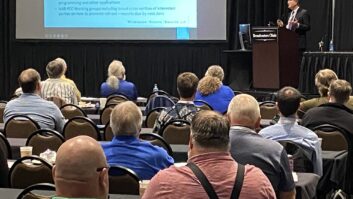Today, Connecticut, like so much of the Northeast, is being hit by the fourth significant winter storm in two weeks, highlighted by the Jan. 26–27 blizzard that dumped more than two feet of snow in some locations – up to 34 inches reported in Thompson.
“Connecticut radio and TV stations have made it their priority to continue to inform residents across the state about what to expect, how to keep safe and what is going on as it happened,” according to Connecticut Broadcasters Association President Michael Patrick Ryan. “Broadcasters have devoted innumerable hours to storm-related coverage by expanding scheduled news shows, adding storm coverage and interrupting scheduled programming to provide special announcements.”
During the major weather events, the governor has activated the state’s Emergency Operations Center and used Connecticut’s statewide network of broadcasters to inform residents about weather conditions, travel bans and work being done by the state to maintain public safety, according to the CBA. Many Connecticut broadcasters have aired the governor’s news briefings live, stationing reporters at the EOC to provide updates as they became available from state officials.
These intense storms have created a number of challenges for Connecticut Broadcasters Associations members, who are determined to do their jobs and inform the public, regardless of the difficulties.
In January along, according to the CBA, WTIC(AM), Hartford managed storm-readiness preparation at its station and transmitter sites, ensuring that its generator was ready for multiple days of service if necessary. The news station arranged for staff to broadcast from home in case they couldn’t get to the station and for other staffers to stay in nearby hotel rooms. Still others chose to sleep at the studios in order to keep the station on the air. Once the storm hit, WTIC dedicated full days to storm coverage, providing weather reports, information about road conditions and closings along with safety tips about topics including wind chill, propane heaters and generators.
On the eastern side of Connecticut where the storm hit the hardest, Hall Communications kept its six radio stations — WCTY(AM), WICH(AM), WKNL(FM), WNLC(FM) and WILI(AM/FM) — in full operation, according to the CBA, which adds that Hall stations provided storm updates, carried the Governor’s press conferences, and had the New London mayor and the local Emergency Management Director on the air several times. Staffers stayed overnight at the local stations or in nearby hotels in order to stay on the air.
In Danbury, WLAD(AM) radio put staffers up in a local hotel and expanded its local programming in order to provide live weather and traffic information, and air interviews with officials from the towns of Danbury, Ridgefield, Bethel and Brookfield. In addition to broadcasting the governor’s news conferences, WLAD put listener calls on the air to share their personal storm stories.
In the Connecticut River Valley, WMRD(AM) and WLIS(AM) radio stayed on the air by having someone sleep at the stations throughout the storm. Among other stories, they were able to report on a local power outage that was caused by a snowplow knocking down a power pole.
For WINY(AM) in Putnam, the story was about being prepared itself. That included the station gassing up an all-wheel-drive vehicle to get radio personnel to work, contacting Putnam police to serve as potential back-up transportation, testing the station’s generators and checking fuel levels, and providing meals for staff who stayed in nearby hotel rooms that were booked by the station.












